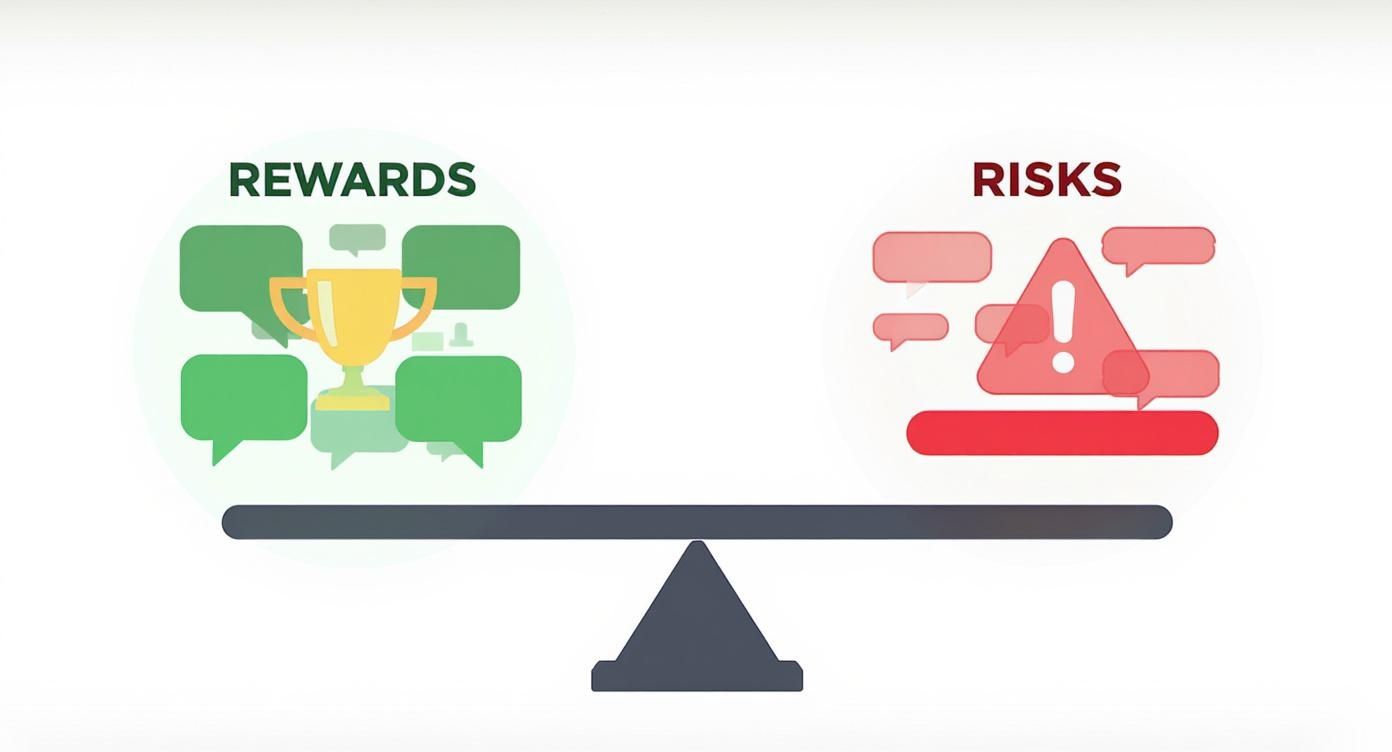At its heart, a reciprocal link is a straightforward deal: Site A links to Site B, and Site B links right back to Site A. It’s an “I’ll scratch your back if you scratch mine” arrangement that has been around since the earliest days of the web.
But while the concept is simple, its role in modern SEO has become much more complicated.
Understanding the Reciprocal Link Handshake

Think of it like a professional referral between two local businesses that complement each other. For example, if a Kansas City landscaping company that designs beautiful outdoor patios links to a high-end patio furniture store, and that store links back from a blog post about "Completing Your Outdoor Oasis," they've created a natural, mutually beneficial partnership.
Online, that "referral" is a hyperlink. When it goes both ways, you’ve got a reciprocal link.
This practice was a cornerstone of SEO in the late 1990s when search engines were far simpler and relied heavily on raw link counts. As Google rose to dominance, deliberate link swaps became a go-to tactic, with some estimates suggesting over 60% of websites were actively trading links to climb the rankings. Find out more about the history of link building tactics on adamconnell.me.
Today, however, Google is much smarter. Context is everything. The link between that landscaping company and the furniture store still makes perfect sense to both customers and search engines—it’s a helpful recommendation. But a link between that same landscaper and a local car repair shop? That feels random, forced, and a lot less authentic.
Understanding this distinction is the key to using reciprocal links safely in 2024.
How Reciprocal Links Compare to Other Types
To really get a feel for this, it helps to see how reciprocal links stack up against other common types of backlinks. Not all links are created equal, and their structure tells a story about the relationship between the two websites involved.
Knowing the difference is critical before you even start to think about how to check backlinks in Google.
A Quick Guide to Different Link Types
This table breaks down the most common link structures to clarify how they work and how search engines generally perceive them today.
| Link Type | How It Works | Common SEO Perception |
|---|---|---|
| Reciprocal Link | Site A links to Site B, and Site B links back to Site A. | Can be valuable if relevant and natural, but risky if done excessively or for manipulation. |
| One-Way Link | Site A links to Site B, but Site B does not link back. | Highly valuable; seen as a genuine endorsement or citation. |
| Three-Way Link | Site A links to B, B links to C, and C links back to A. | An older tactic to hide link swaps; now easily detected by search engines as a scheme. |
As you can see, the one-way link is the gold standard because it’s a pure, unprompted endorsement. Reciprocal links, on the other hand, carry both potential value and potential risk, depending entirely on how and why they are implemented.
How Search Engines See Reciprocal Links Now

Back in the early days of SEO, a reciprocal link was a simple handshake deal that pretty much always worked. Search engines were basically just counting links, and the more you had, the better you ranked. Simple as that.
But that era is long gone. Today, search engines like Google look at these kinds of arrangements with a whole lot of skepticism.
The game changed when the algorithms got smart enough to understand intent. They started asking a critical question: was this link created to actually help a reader, or was it just a sneaky trick to pump up search rankings? This shift was supercharged by major algorithm updates, especially Google Penguin, which started actively penalizing sites for building unnatural-looking link patterns.
Think of it like getting a recommendation. A genuine referral from a respected colleague carries a ton of weight. A paid endorsement you arranged yourself? Not so much. Search engines now apply that exact same logic, spotting the difference between a natural connection and a forced one.
The Red Flags of a Manipulative Link
So, what makes a reciprocal link look suspicious? Search engines have gotten incredibly good at sniffing out link exchanges that are clearly just for SEO. They hunt for patterns that just don't make sense from a human perspective.
Here are the big warning signs they look for:
- Excessive link exchanges: A huge chunk of the sites linking to you are the exact same ones you're linking out to.
- Irrelevant partners: Linking between two completely unrelated websites, like a plumber trading links with a pastry chef. There's no logical reason for that connection.
- Over-optimized anchor text: Using the exact same keyword-stuffed anchor text over and over again. For example, if both sites use "best SEO company in Kansas City" as the link text, it’s a dead giveaway of manipulation.
- Joining link schemes: Getting involved with private networks or "link farms" built for the sole purpose of trading links.
All these factors add up to a messy and unhealthy link profile. It’s vital to know how all your site's connections look to a search engine. You can get a much deeper understanding of this by reading our guide on what a backlink profile is.
The key takeaway here is that search engines penalize the intent to manipulate, not the simple act of a reciprocal link. A few natural, relevant links between trusted partners is totally fine and usually flies right under the radar. The real problem starts when you build these links at scale, with the single-minded goal of gaming the system.
At the end of the day, context is everything. A link’s real value comes down to its relevance, the authority of the site it’s on, and whether or not it genuinely makes the user’s experience better.
Weighing the Risks and Rewards of Mutual Linking
Reciprocal linking isn't a simple "good" or "bad" for your SEO. Think of it less like a switch and more like a sharp tool—in the right hands, it can be incredibly useful, but a careless approach can cause some serious damage.
When done right, the upside is all about building genuine connections. A well-placed mutual link can drive a stream of high-intent referral traffic straight to your door. Imagine a local Kansas City web designer linking to a content writer they trust. Visitors looking for design services are probably fantastic leads for writing services, too. It’s a natural fit that also helps build valuable industry relationships for future collaborations.
But the risks are just as real, and they can be far more painful if you ignore them.
The Dangers of a Poor Linking Strategy
The biggest danger is tying your brand's reputation to a low-quality or irrelevant website. Linking out to a spammy, untrustworthy site is like giving a public endorsement to a sketchy business; it can instantly damage your credibility with both users and search engines.
This leads directly to the risk of getting hit with a penalty. Google is incredibly good at spotting patterns that look manipulative. A sudden explosion of tit-for-tat links, especially with sites that have nothing to do with your industry, sends up a massive red flag.
Such patterns can be interpreted as a "link scheme," a direct violation of Google's guidelines, which may result in a manual penalty that tanks your rankings and organic traffic overnight.
Making an Informed Decision
At the end of the day, the goal is to create a link that offers real, tangible value to your audience. A healthy partnership link feels natural because it connects two resources that genuinely complement each other. For instance, an e-commerce store that sells hiking gear linking to a popular trail guide blog makes perfect sense for the reader.
A toxic link, on the other hand, feels forced and serves no real purpose. Think about that same hiking store swapping links with a personal injury lawyer—it’s just bizarre and helps no one. The key to avoiding these traps is to relentlessly focus on quality over quantity. Developing a strong foundation is everything, and you can learn more about how to do that by exploring our comprehensive guide on how to improve website SEO.
A single, high-quality reciprocal link from a relevant industry authority is worth far more than dozens of low-value links from random websites. The rewards are definitely appealing, but only if you navigate the risks with a clear, careful strategy.
Reciprocal Linking at a Glance Pros vs Cons
To make your decision easier, here's a quick breakdown of what you stand to gain versus what you could lose. Use this table as a quick gut check before agreeing to any link swap.
| Potential Benefits (The Upside) | Potential Risks (The Downside) |
|---|---|
| Drives highly relevant referral traffic. | Damages credibility by associating with low-quality sites. |
| Strengthens industry relationships and partnerships. | Can trigger a Google penalty for "link schemes." |
| Can provide a modest boost to SEO authority. | Dilutes your link profile if overused with irrelevant partners. |
| Introduces your brand to a new, targeted audience. | Wastes time and resources with no real SEO benefit. |
Ultimately, weighing these factors will help you distinguish a strategic partnership from a risky gamble. Always prioritize genuine value for your audience above all else.
A Practical Framework for Safe Reciprocal Linking
Alright, let's move from theory to what actually works. Building reciprocal links safely isn't about finding clever loopholes to trick Google; it’s about creating genuine partnerships that make perfect sense to both users and search engines. This framework is all about making smart, strategic decisions that keep you on the right side of the line.
The very first step is to be incredibly picky about who you partner with. Don't get star-struck by a high domain authority score. Instead, zoom in on what really matters: topical relevance and audience overlap. Ask yourself the simple question: does this website serve the same kind of people with complementary information? A link between a Kansas City home inspector and a local real estate agent just feels right, because their audiences are one and the same.
This infographic lays out the rewards and risks you need to weigh before ever agreeing to a link swap.

As you can see, while the upside of referral traffic is great, the risk of a Google penalty is just as real. This is why careful partner selection isn't just a suggestion—it's everything.
Cultivating Natural Partnerships
Once you’ve found a site that feels like a good fit, your outreach needs to be about building a real professional relationship, not just making a cold, transactional request. We've all gotten those spammy "link swap?" emails. They're a massive red flag and usually go straight to the trash.
An actionable insight is to engage with their work first. Share one of their articles on LinkedIn, leave a thoughtful comment on their blog, or connect with them on social media. When you finally do reach out, frame your idea around a mutual win for your audiences. Something like, "I loved your guide on home staging and thought my article on pre-sale renovations would be a great resource to share with your readers." This positions the link as a genuine value-add, not a scheme.
The golden rule is simple: place links where they feel completely natural and helpful within the content. A link should never feel forced. This is a core principle for any effort to build backlinks naturally.
At the end of the day, reciprocal links should only be a tiny slice of your overall backlink pie. The vast majority of your links should be one-way endorsements you've earned through great content and smart outreach. In fact, while mutual links are common—one Ahrefs study found 73.6% of popular domains have them—they most often happen organically, without any formal agreement.
Red Flags: When to Just Say No to a Reciprocal Link
Knowing when to say "yes" to a link is important, but knowing when to hit the delete button on an offer is what will really protect your site. Not every opportunity is a good one, and a bad link partnership can actively poison your site's authority. Learning to spot the red flags is the first step in defending your backlink profile.
The most glaring warning sign is an offer from a totally irrelevant website. If you run a Kansas City-based marketing agency and get a link swap request from a pet grooming blog in another country, there’s just no logical connection there. A link like that adds zero value for your audience and, frankly, looks incredibly suspicious to search engines.
Another massive red flag is any mention of payment. Let’s be clear: Google's guidelines are black and white on this. Buying or selling links that pass PageRank is a direct violation, and it’s a fast track to getting a penalty.
Common Dangerous Link Requests
You need to be skeptical of those generic, automated-sounding emails that land in your inbox making grand promises. These are almost always the gateway to a low-quality arrangement that will do more harm than good.
Keep an eye out for these specific traps:
- Invitations to link networks: These are shady, closed-door clubs of websites that exist only to link to each other and try to inflate their link counts. They are the textbook definition of a link scheme.
- Links from spammy websites: Do a quick 30-second check of the site. If it's loaded with thin content, plastered with ads, or just looks poorly designed, run the other way. An actionable tip is to check their recent blog posts—if they're low-quality or AI-generated, it's a sign of a site to avoid.
- Offers from "link-only" pages: Some sites have a page called "Partners" or "Resources" that’s nothing but a long, messy list of unrelated links. These provide next to no SEO value and are easily sniffed out as manipulative.
If you find your site is already tangled up with toxic domains from past mistakes, it's critical to clean house. Understanding how to build a Google disavow list is an essential skill for protecting your site's health from the damage these bad links can cause.
Got Questions About Reciprocal Links? Let's Clear Things Up.
Navigating the world of reciprocal links can feel like walking a tightrope. It's totally normal to have questions pop up. So, let's tackle some of the most common ones I hear from clients to help you make smart decisions for your SEO.
How Many Reciprocal Links Are Too Many?
Honestly, there's no magic number here. The real question isn't "how many," but "how natural does this look?" A few logical, relevant reciprocal links sprinkled into a healthy backlink profile are perfectly fine and usually fly right under the radar.
The trouble starts when you have a pattern. If a huge chunk of your backlinks are mutual exchanges, especially with sites that have nothing to do with your industry, it starts to look like you're trying to game the system. A good rule of thumb is to keep reciprocal links to a small fraction of your overall profile.
In the eyes of a search engine, not all links are created equal. One-way backlinks are seen as a much stronger, more organic endorsement. As a general benchmark, try to keep reciprocal links to around 10–15% of your total backlink profile to maintain a natural pattern. You can discover more insights about link weight on bluehost.com.
Are Three-Way Links a Safer Bet?
Three-way linking (where Site A links to Site B, Site B links to Site C, and Site C links back to Site A) was a popular trick back in the day to try and hide a link exchange. People thought it was a clever way to outsmart Google.
But here's the thing: search engine algorithms are way more sophisticated now. They can spot these manufactured linking patterns from a mile away. While it might be a little harder to trace than a direct swap, if it's done at scale to manipulate rankings, it's still considered a link scheme. Your time is far better spent building real relationships, not complex webs.
Can I Actually Get a Google Penalty for This?
Yes, you absolutely can. Google is very clear about this in their guidelines. Engaging in what they call "excessive link exchanges" or any program set up just to trade links for rankings is a direct violation. This can trigger a manual action—a penalty handed down by a real person at Google.
A penalty like that can be devastating. Your rankings could tank overnight, or your pages could even be dropped from the search index entirely. This is exactly why every link exchange has to be grounded in genuine user value, not just SEO ambition.
Should I Disavow Low-Quality Reciprocal Links?
If you've got some spammy reciprocal links from years ago, the first step is always to reach out and politely ask the other site owner to remove it. If they don't respond or if the links are part of a larger toxic pattern, then using Google's Disavow Tool is a reasonable next step.
But use this tool with extreme caution. It’s like performing digital surgery. Disavowing links you don't need to can sometimes do more harm than good. Only use it as a last resort for links that are obviously manipulative and that you can't get taken down manually.
At Website Services-Kansas City, we specialize in building powerful, natural backlink profiles that drive real growth without the risks. Let our SEO experts create a strategy that builds your site's authority the right way. Get in touch with us today.